Author's Note: This is part two of a retrospective on Final Fantasy III. If you missed the first part of this series, here's the link:
Part 6: The Point When Things Start To Become A Blur
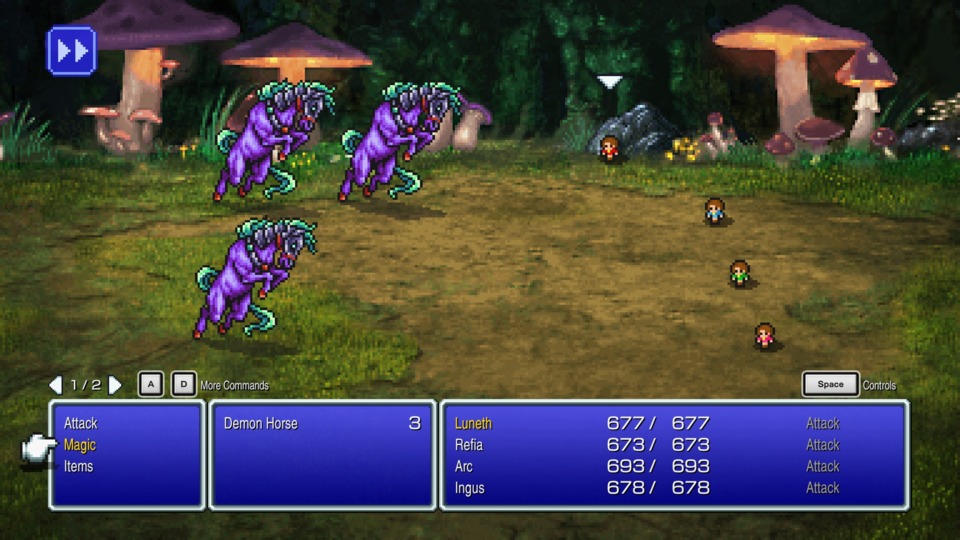
Well, look at me dropping the ball on my writing goals for almost the entire start of 2024! After promising myself that I would set my blogs up to cover Final Fantasy VII Rebirth's release, here I am, scrambling to finish projects from last year. With my retrospective on Final Fantasy III, my writer's block stemmed from an unmistakable struggle with maintaining enthusiasm. It's not that I consider the game terrible, per se; it's just that so much of it feels like the Final Fantasy team going through the JRPG motions as they still try to figure out what they wanted the series to be. This mental exhaustion might come as a slight surprise to those of you who may recall where I left off in the first part of this series, wherein I was relatively enamored by its attempt at echoing the series' penchant for world shifts but, at the grandest scale, the series had seen up to that point. And it bears repeating that the game's sense of scale is impressive for a Famicom/NES game. Unfortunately, while the size of its many worlds is immense, there's no doubting how empty they feel, and the gameplay's repetitious template guts whatever favorable concessions I want to give it about its scale.
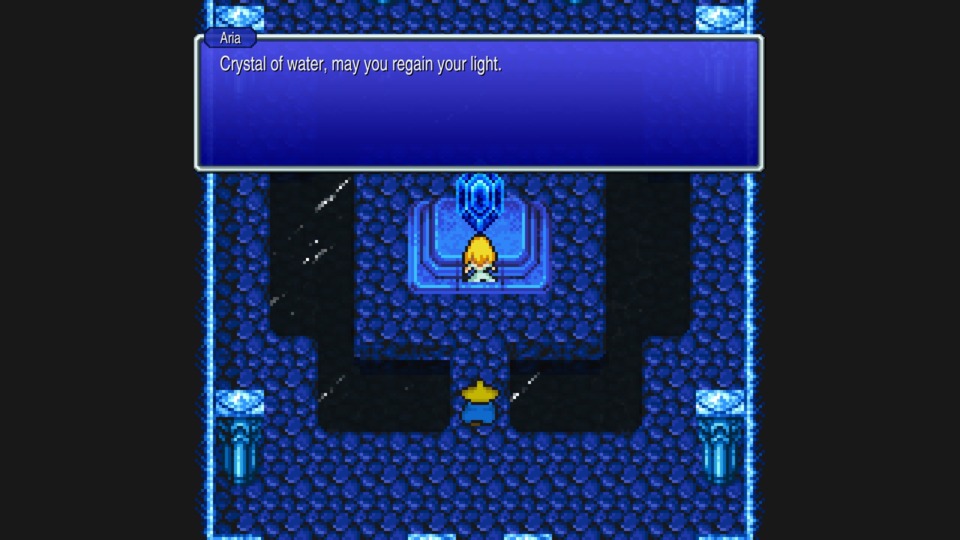
It's definitely "cool" when the game goes from its starting circular world to the "Flooded World," but it sure does suck using the airship to navigate to the three-ish locations that are explorable, which allows the game to make way to its final map. But before you can do that, you follow the same formula for how Final Fantasy III structured its previous dungeons: find a companion to tag along with you, buy new equipment and potions from a vendor, enter a dungeon, and keep going until you beat the boss at the end of the dungeon. Worse, the game still subjects you to that excruciating feeling when you realize you just aren't going to make it to the final level of a dungeon and likely need to punch out and make the walk of shame to an inn to restore your spell slots and HP as well as restock on items. The good news is that because Final Fantasy III has a job system, you have something to show for your exploratory efforts. Still, because this is a prototype of the Final Fantasy job system we know and love, the sense of progression here is not satisfying. The stat increases to your jobs are nice, but you still have to buy spells from magic vendors, and remembering where the best armor and weapons are for the different martial class types is a chore.
Luckily, the dungeons in Final Fantasy III are far shorter than what Squaresoft made in Final Fantasy II, and as I highlighted last episode, the Pixel Remaster has a handy mini-map that makes almost every single one a linear trek with no tricks to worry about beyond its random encounters. But that returns us to the unfortunate downside of Final Fantasy III's highly repetitious core design. In the case of the start of the Flooded World, the game hilariously transitions you from a mini-dungeon back to the overworld and immediately into another, more in-depth dungeon. As a result, what you are left with is a consistent but incredibly slow throwback to what JRPGs felt like over thirty years ago. These games felt like work, and that's because they were mainly abiding by the design philosophies of Yuji Horii, the man who gave the world Dragon Quest, who maintained that roleplaying games should not be a matter of if you reach the end, but instead, a matter of when as long as you kept putting in work. What makes Final Fantasy III hard to go back to beyond the fact that it enjoys stomping your teeth in is that there's very little in the way of variety. With the Cave of Tides, there are only five enemy types, one of which is a rare encounter, and the differentiator is instead what mixes of those five enemies you'll fight during random battles. The dungeon after it is a sewer sequence also with only FIVE enemy types, and the one after that is a haunted mansion with just SIX!
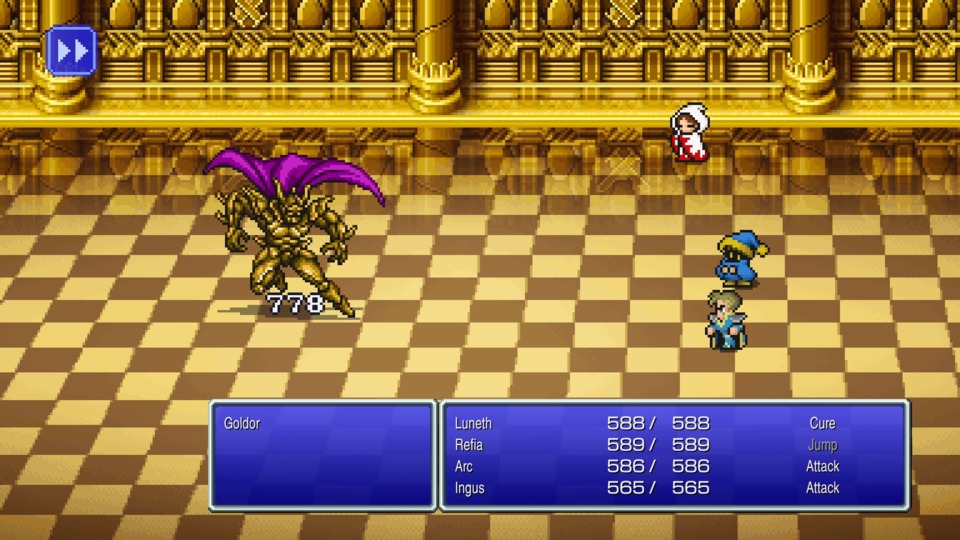
There are two significant points with the need for gameplay variety in Final Fantasy III, one of which I will talk more about in the next sub-chapter. The first is that while there are a plethora of jobs for you to mull over, almost all of the levels, even well into the game's final act, have a gimmick that incentivizes one or two jobs over the rest of your options. That means you are forced to retool your parties to sport similar jobs and repeat the same moves ad nauseam. The fun work Squaresoft did to animate epic summons, cool top-tier spells, and flashy weapon-based flourishes only opens up at the end of the game, where you can fuss about in the overworld with the jobs you enjoy using. However, for most of the game, you watch the same moves repeatedly for HOURS because there are sequences that practically require you to use jobs like the Dragoon or Dark Knight. And it's way worse for the bosses in Final Fantasy III! Often, there are only one or two truly "correct" moves to do adequate damage to a boss, and deviating from those two moves is a waste of your time. As you attempt to get the Water Crystal, you fight the Kraken, which is weak to lightning-based magic, and hopefully, you have adequately leveled Black Mages with spell slots to spend on Thundara. If not, you're going to be miserable.
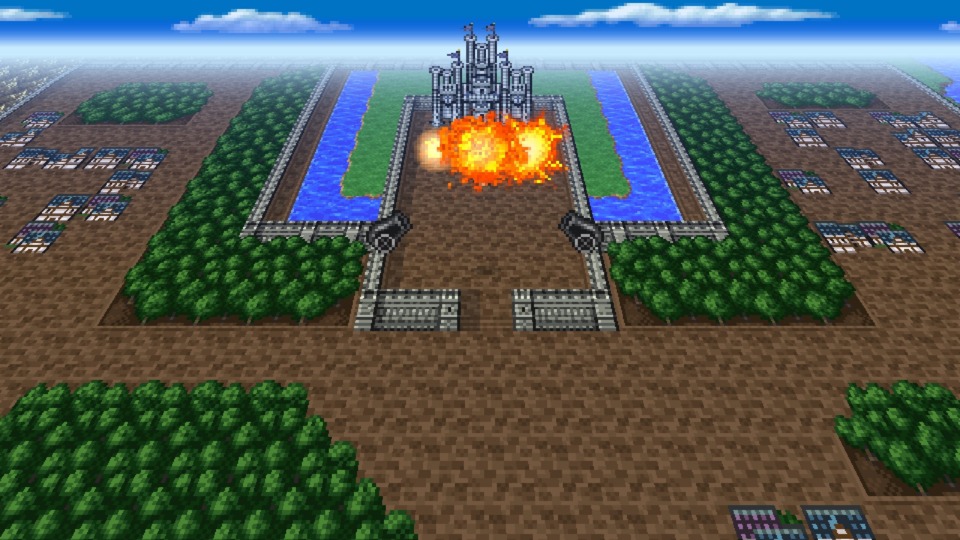
That leads us to the other problem with Final Fantasy III, which makes me comfortable calling it a "blur." When you realize a level or environment is not so ambiguously directing you towards a specific job or class, if you have yet to touch that job, you'll likely have to dedicate time, sometimes upwards of twenty to thirty minutes, to grinding away levels. If this were Final Fantasy V, wherein the jobs provide you with overlapping buffs and synergies, that wouldn't be a big issue, but this is Final Fantasy III, where every job seems isolated. Your character's core stats beyond HP seem largely irrelevant. The good news is that when you park your party at the entrance of dungeons with an assortment of new job assignments, you can get the gist of what you need to do for the rest of the dungeon with little to no risk of meeting an untimely demise. The issue is that this game's jobs progress at a snail's pace and still use the Vancian-inspired spell slot system. For the start of the game, those spell slots, more than your HP, limit how far you progress in a dungeon, as not having the appropriate magic abilities at your disposal slows every combat encounter to a crawl. It's slightly better with the dungeons that require job-specific special skills that don't use spell slots, but not by much because the damage those abilities deal is determinant on your equipment and your character's job proficiencies, which usually result in your parties being incredibly top heavy as you only have the resources and gil to spec two of your characters to deal satisfying damage.
Part 7: This Game Is Obsessed With Gimmicks
At this point, I will speed through most of the game's middle levels. After finishing things up with the Water Crystal, you eventually find yourself in the estate of a knight named Goldor. This mansion has three levels, and the gimmick is that everything, including the boss, is resistant to magic, and you are encouraged to opt for the game's martial classes. After wrapping things up there, the following required location is Saronia, one of the more impressive locals in the game, as it is a massive city. The game even sections Saronia into four distinct parts. There's even a fun cutscene when the defenses of Saronia shoot down your airship, which, again, is another example of the game pushing the technical limits of the NES. Saronia is also one of the more well-known gimmick levels in the game. If you press people to say anything they know about OG Final Fantasy III, some will tell you there's a boss in the game you can one-shot if you use a Dragoon's Jump command. This set piece is where that happens, and it's not as if there's any honor in playing that boss encounter any other way. The battle either ends in under three turns, even if you have yet to use the Dragoon class up to that point, or you have to miserably deal with Garuda spamming Lightning attacks that deal 300-400 damage per party member ad infinitum. But hey, at least you get to see Final Fantasy do its best impression of Wormtongue and King Théoden from The Two Towers.
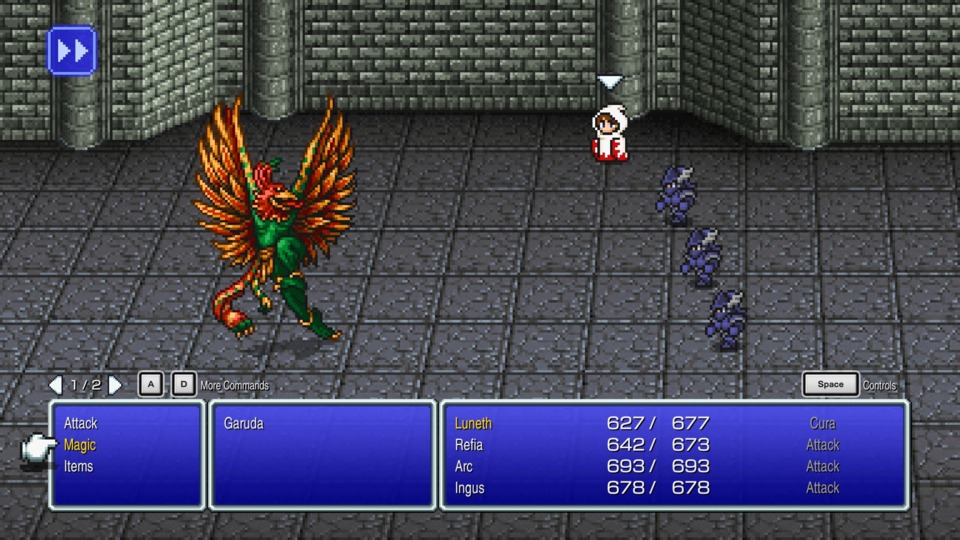
Equally gimmicky are the themes of all the required and optional cities you can explore during the game's mid-point. I'm incredibly conflicted about this part of Final Fantasy III. On the one hand, the amount of content in here is astounding, and you can tell the Final Fantasy team finally started to grapple with the concept of side quests as a crucial part of the RPG formula. On the other hand, because all of these cities are tied to one or two specific jobs, until you get the final airship, which has a vending machine that mercifully sells almost everything in a single location, traveling to individual cities to equip one or two jobs properly for upcoming combat encounters is the worst. THE. WORST. The city with the sages (i.e., Doga's Village), which, until the Eureka Cave, has the best white and black magic spells, requires a complex procedure of going underwater and navigating a series of environments to get to its magic dealers. But, more fundamentally, it was annoying getting a new job or wanting to try something out for the first time and then needing to pull up a guide to know where the one place with even the most basic equipment for that job was located. Nonetheless, these locations usually have short dungeons with full-on quests that give you uncomplicated opportunities to try out the jobs they are connected to and grapple with their upsides in combat.

The middle act of Final Fantasy III is not a tortuous affair, but it is annoying. The vexing Mini-based dungeons are not entirely gone, at least not until the game's final act. When you attend to matters with Doga and Unei, there's a three-dungeon sequence with a Mini-dungeon to boot, where none culminate with the expected epic boss encounter. Likewise, the Mini-dungeon is an irksome gate on your ability to progress as it essentially burns two spell slots by default. Other aggravating things crop up during this part of the game as well. The Temple of Time, rather annoyingly, doesn't drop a teleport on the final floor, which prompts you to either make the trek back to the surface manually or use an item or Teleport spell to spare you that misery. The game follows this level with the Sunken Cave and Ancient Ruins, which also do not have any capstone boss encounters, which is an odd omission. I get the Sunken Cave is an optional dungeon with nothing more than loot for you to enjoy. Still, it's curious that the Ancient Ruins, which is the location that requires the Dark Knight, does not have a boss encounter where you finally put everything you've learned about that particular job into a satisfying conclusion. Instead, you slog through many ooze-themed trash mobs that divide if you attack them with anything but the Dark Knights' Dark Blade. It's a seven-floor-long dungeon with one overriding gimmick that wears thin by the second floor and doesn't even properly conclude, and this is not the first or only example of that in Final Fantasy III.
But the annoying gimmicks apply to more than just the dungeons! Sometimes, gaining the full efficacy of a job requires you to perform additional side quests and tasks, with the most apparent example being the summoning-oriented jobs. The optional summons are all cordoned off to far corners of the map and don't climax to anything more than you getting some cool-looking monsters you can will into existence. Predictably, the dungeons leading to the new summonses, like the rest of the game, are tied to specific elements or strategies, which prompt you to use just one or two moves until you reach their end. More puzzlingly, the gimmicks of Final Fantasy III even extend to your ability to explore its overworld, as your final airship is by far one of the worst in franchise history as it is limited in what it can do. Unlike other final airships in the series, the Invincible can only "hop" over mountains but ones that are only one tile thick. Also, flying the Invincible doesn't turn off random encounters, and you have to enter and exit it using a ladder rather than landing it on the ground and immediately entering and exiting it. The game's final airship being unable to fly over everything and land means you must juggle the placements of your earlier vehicles to continue exploring previous towns and merchants. It also means that there are overworld maze levels where you are using the airship to navigate outdoor labyrinths that suck to play and figure out.
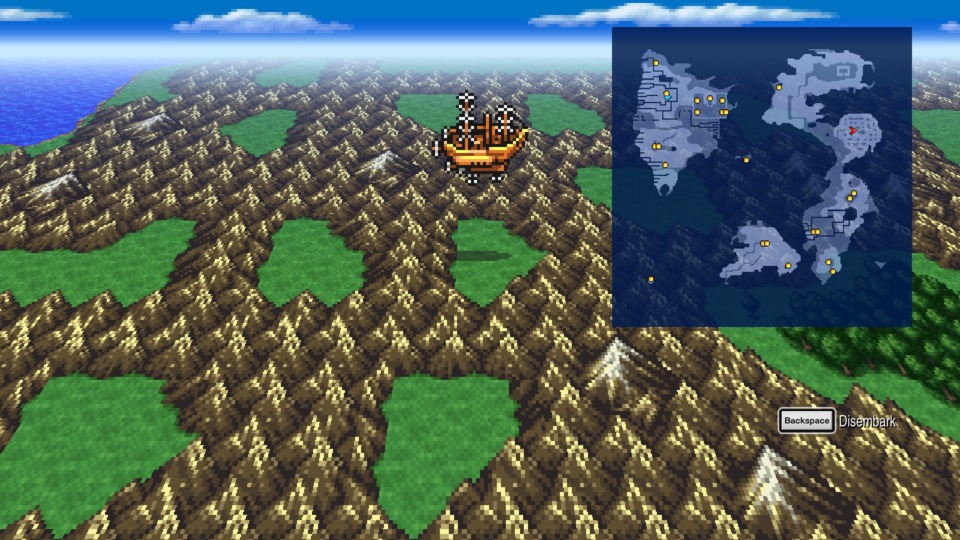
Nonetheless, the intent of the designers is admirable. Their game is massive, with many jobs and character builds to mull over. As a result, they decided that the only way for people to be able to move forward was to force them to opt into systems and mechanics they might have skipped if none of these dungeons and sequences were there in the first place. Furthermore, let's not pretend this wasn't what Dragon Quest had done twice prior. Many of these annoying quirks I just groused about were genre hallmarks at the time. This shakable truth is why I disagree with the overriding sentiment online that this game is one of the hardest in the series. Until you get to its final gauntlet, which I will discuss in this blog, when you follow the game's script and do what it expects you to, it's no different than what you would experience in JRPGs of this era, especially when compared to its contemporaneous Enix, Atlus, or Nihon Falcom-made peers. When you figure out the most efficient path to beating a level or sequence, the game is cake, and it's less about if you'll beat the dungeons and more or less how long it will take and if you can complete them in one go. It is punishing when you have even one character in your party not toeing the line, and the puzzle-like railroading severely limits your ability to play around with its main selling point, its variable job system. Still, until you get to the Cloud of Darkness, most of your challenges have solutions that are a stone's throw away.
Part 8: There's A Story With The Expected Final Fantasy Twists, I Guess
Upon defeating Hein in his massive tree-like fortress in the sky, one of the most striking visual set pieces the game showcases, you learn more about the machinations of what is driving your character's call to adventure. Hein shares that they are taking orders from someone named Xande, who is dissatisfied with the world's current order and pantheon of mythological figures. After offing him and eventually making the trek to the Temple of Time to pick up a lute that someone named Unei desires, you get a crash course on what's driving Xande's quest to explode the universe. Unei and their companion Doga explain that they and Xande were once students of a great wizard long ago named Noah. As he trained his three disciples, he gifted Unei power over the dream dimension, Doga vast knowledge of magic, and Xande the gift of mortality. Believing he was robbed and fearing for his death, Xande has been on a mission to cover the world in darkness to reverse his mortality. The flooded world wherein most of the universe's living people are petrified was his doing, and he presently sits atop the Crystal Tower, where he continues to further this plan. They even explain that the floating continent that our heroes come from was once a part of the flooded world but was thrust into the skies when Xande drained the Earth and Water Crystals of their power. The monsters that we have been fighting as random encounters? Xande's been creating those beasts in his towering monolith, hoping they would off your party.
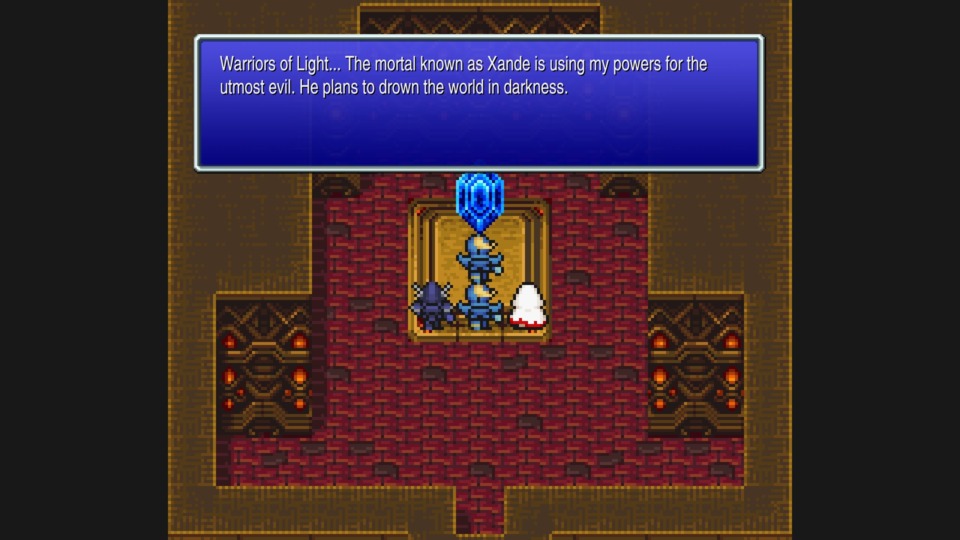
In my last blog, I repeatedly used the word "quaint" when describing why I did not want to dismiss Final Fantasy III outright, even while I struggled with some of its systems. This story is familiar to those of you who have played other 16-bit and even PS1 entries in the series, and seeing which parts of the Final Fantasy DNA start in III is one of the most rewarding parts of playing it. While Final Fantasy I's plot twist with Garland is a fun surprise, the presence of over a dozen named characters in II makes it the first "real" attempt at storytelling from the Sakaguchi-era team. That aside, III is when the outline of the Final Fantasy formula feels thoroughly established. From this point forward, elemental crystals and a pantheon of gods and goddesses, which echo proper nouns from the previous games, feel forever intertwined with what we expect of these games. More than that, Final Fantasy III feels like the first genuine attempt at exploring themes of death and putting at least some sympathetic veneer over your overriding antagonist. Xande is a bog-standard fantasy villain, but the fact there's an understandable reason for his turn to evil is something few other RPG franchises bothered doing in 1990. I said I would avoid talking about the 3D remake during this retrospective, but I cannot dance around how the additional storytelling for Xande and your party members kicks into high gear at this point. In the 3D Remake of III, your party members start to transform into individuals with their own moral compasses and life experiences that you learn more about through character-specific story arcs and missions. I understand why the Pixel Remasters do not include those additional story bits. Regardless, part of me does wish they were included because the reality is that the world of Final Fantasy III shows promise that ultimately goes nowhere.
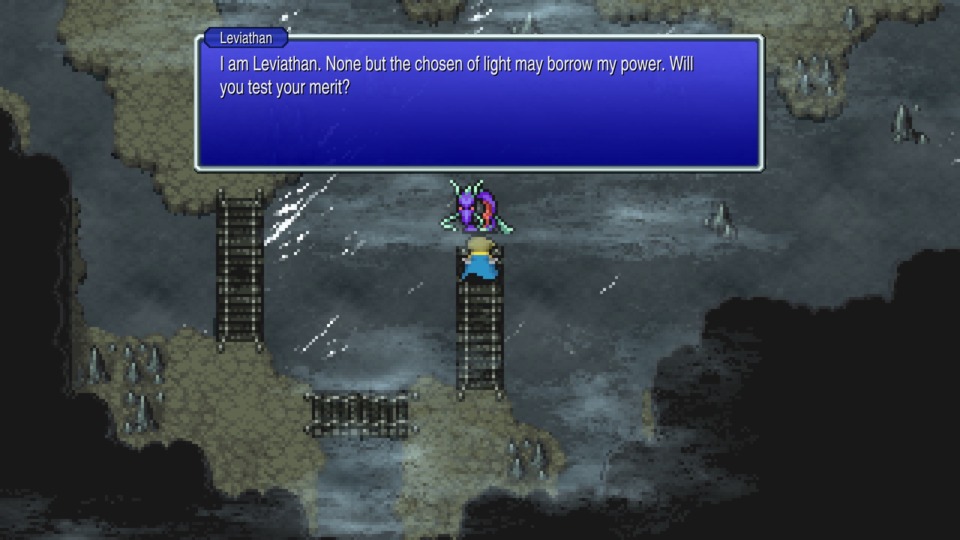
It's frustrating, but Final Fantasy III's design and programming team buckle at the weight of the world they created. Because this game emphasizes scale and size, it has no other recourse but to send you off on ANOTHER MacGuffin chase so you can bust down a powerful barrier preventing you from immediately storming Xande's tower. Do the new environments that we go to following our long talk with Doga and Unei do anything more to address how the world of Final Fantasy III works or what evil lurks in the darkness? Not really. There's a single NPC in Replito that can tell you how Noah died, but he's incredibly easy to miss. By this game, the programmers understood that having NPCs say more than basic greetings can add to an RPG's worldbuilding, but this game does a terrible job communicating that point. Your non-story world interactions are incredibly inconsistent. For example, Unei and Doga mention that their master, Noah, was the one who sealed Bahamut away after fearing the legendary dragon would smite the world and its citizenry with its powerful magic. When you track down Bahamut, he says about two sentences, and then you smash cut to a boss fight. He does not mention their connection to the legendary Noah when you defeat him. The reason is that animating the summons and including them in the first place was the priority instead of making them feel like authentic in-universe additions. They are fantastic to look at, especially in the Pixel Remaster. Still, they feel skeletal due to their inauthentic connection to the story, a shortcoming that Final Fantasy IV and VI masterfully rectify. But credit to III for starting this series's trend of having epic summoning magic in the first place!
It's a bummer because the tools and resources for making the story in Final Fantasy III better are in the game and right there. The guest characters are another way that the game tries to opt you into viewing the world of Final Fantasy III as more than the sum of its parts, but these characters are also incredibly inconsistent. If you're playing the 3D remake, they are slightly better with new storylines and fun ways in which they help you in battles, but in the original game, they only have a few lines to spout as they follow you around in one or two dungeons. Worse, as is the case with Desch, you can miss what connection their part in the story has with the rest of the world if you don't take the time to talk with every single NPC in the game. It's a hallmark of the genre, especially during this era, but it's wild going back to this game and realizing you can altogether avoid his girlfriend and miss out on the one part that links his contributions to the story to Final Fantasy III's surrounding world. Nonetheless, in all versions of Final Fantasy III, most of these guest characters amount to you leading them to their deaths at the end of dungeons. Hence, the game can further an over-arching theme about not being afraid of death, but it's surface-level at best, and the fact the game employs this metaphor four times in a row is laughable. The death eulogies are sparsely written and unintentionally funny. One or two extra lines or an additional scene here or there would have gone the distance in making the guest characters feel like worthwhile additions to the party, but that's not the case, and it's frustrating.

However, while sparsely told, there are times when Final Fantasy III's narrative works. The game's best storytelling moment beyond the initial reveal of the Flooded World and its ending happens at the finale of Doga's Grotto. When Doga and Unei accompany you briefly during your journey, they make vague hints about an upcoming challenge of your party's prowess. When you reach the end of Doga's Grotto, the two wizened sages transform into monsters and command you to defeat them in battle. As you do, the two share the last bits of their knowledge about how to defeat Xande as they enter the afterlife. They implore your party not to treat death as a punishment or form of torture as Xande does but as a certainty that frames the importance of living your best life. If it sounds like familiar territory, that's because it is, especially in the Final Fantasy series, and I don't think it's too much of a stretch to claim that future Sakaguchi-led Final Fantasy efforts like VII or IX are not at least a partial continuation of the notions of death and the afterlife that Final Fantasy III started. Furthermore, what is notable here is that the music works with what Doga and Unei are trying to communicate to the player. It's one of the ur-examples of the Final Fantasy team making an explicitly melancholic cutscene. This point again leads to me wanting to challenge the common theme of people placing this game damn near the bottom of their rankings of the franchise. When a game is this foundational and vital to the maturation of the series, can you conscionably do that?
Part 9: Hitting Final Fantasy III's Wall And The Necessity Of Cheese Tactics

Now, if that last section makes it seem like I'm going to waffle on Final Fantasy III's flaws and shortcomings, I'm not. While I made the case that this game is an RPG puzzle with optimal builds, making the combat almost trivial and repetitious, that all changes after you wrap up your business in Doga's Grotto. Outside of exploring the optional dungeons, collecting the summons, and exploring the Chocobo forests, all that remains is the game's final gauntlet. When people speak of Final Fantasy III as one of the most challenging games in the franchise, this last quarter of the game is what they are talking about. Like every JRPG, Final Fantasy III has a "point of no return," but what makes this version of the trope so heinous is how long it is and how little leeway the game gives you. First, let's talk about the set-up of the final dungeons because that's part of the problem. With the resources necessary to get past Xande's barrier, you must park the Invincible outside a retaining wall surrounding the Crystal Tower. This wall is treated like a separate environment, and it is a winding maze dungeon with the expected dead-ends and monster traps typical of a JRPG dungeon of this era.
When you make your way to the exit of this dungeon, there's a quick moment outside of the Crystal Tower in the overworld before you enter the second phase of the point of no return. You can't park the airship in this space, and remember, Final Fantasy III doesn't have tents and cottages, so you can't use this as an opportunity to heal up and rest your characters.If you want to do that, you must turn around wherever you are in the Crystal Tower and re-complete the maze dungeon before you can finally re-enter the airship and rest inside it. It's THE WORST! The Crystal Tower has SEVEN FLOORS, and the Ancients' Maze has FIVE! All the while, the game starts pulling some cheap shit as it puts you through your paces. In the maze, the final levels can spawn King Behemoths, who, when at low health, spam the Meteor spell for every one of their moves. Your reaction might be to off it with one of your high-tier spells, but considering you are less than a third through the game's finale, you don't necessarily want to use your best attack options. In the Crystal Tower, there's an enemy type named "Bluck," which is relatively easy to defeat if you use magic, but there are far worse things to fight here. However, if you don't act quickly, the Bluck will use every one of its moves to summon enemies until every possible spot for enemies on the screen is filled. So, what do you do? Do you blow them away and hope you get lucky with your subsequent random encounters, or do you pray your regular attacks are enough to get the job done before the encounter becomes a painful, drawn-out battle of attrition? And that's what makes the end of the game so brutal! Here you are with all these powerful items and spells, and you always hesitate to use them. If you use too many, you screw yourself over as you near the end because your spell slots and resources are not where you need them to be.
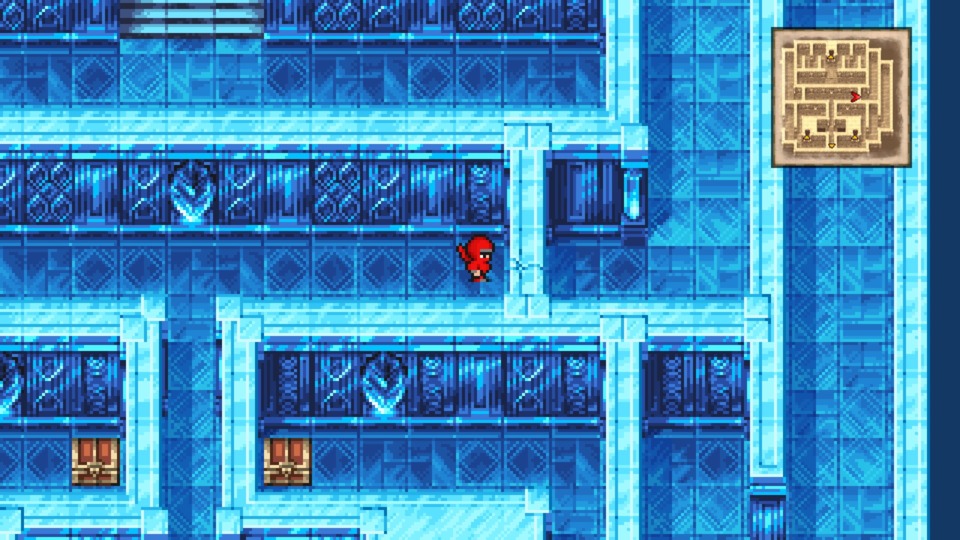
And, OF COURSE, the Crystal Tower ends with a boss battle against Xande, but at least there's a conveniently placed save point to restore your magic and HP. In the NES and Pixel Remaster, Xande is a final "Gear Check Boss" and nothing more. When he attacks, he uses powerful spells like Meteor and Quake, which means the damage he inflicts overrides even your best healing spells, thus making this a timed mission. He's not weak against anything, either. The trick is to do as much damage as you can against him and hope your characters' levels are high enough that they can stomach the damage he gives before the battle is over. That's all there is to it! It's way worse in the 3D remake, as that version affords him two attacks per turn, and he can even buff himself with Haste and Protect. Regardless, if you get to him and feel like he's squashing you within two to three turns, that's the game telling you it's time to head back to the dungeon and start grinding! Part of the dread associated with playing old JRPG dungeons is gone with the Pixel Remaster, as it auto-saves your progress before every battle. Still, it's around here where all of my previous complaints about the combat being repetitious and your character progress being painfully slow can come to a head. If you have run away from even one encounter, the game makes you pay for it.
I have covered a lot of Final Fantasy games as part of this feature on the site, and I feel safe calling Final Fantasy III's final deluge of dungeons and bosses one of the most demanding and most aggressive in the franchise. Maybe you can list an individual Final Fantasy boss or dungeon that kicked your ass that sticks out in your memory stronger than what I am describing here. Trust me, I was there with you, whether it be Necron in Final Fantasy IX, Seymor Flux in Final Fantasy X, or Barthandelus in Final Fantasy XIII. The bullshit you have to do to have the pleasure of seeing the Cloud of Darkness is ridiculous, and it tops all of my previous examples. There's one mercy worth mentioning in Final Fantasy III's favor. It's the fact it has a job (i.e., Thief) that increases your odds of running away from combat, which means you only need to prep for the boss encounters and the optional elite jobs it locks in the Eureka dungeon. That last sentence leads me to a significant concession. Yes, I got the Sage and Ninja jobs. Yes, I spammed Shurikens to kill the Cloud of Darkness. No, I don't have any regrets. Considering how punishing the end of the game becomes if you don't do this, I don't regret leaping on an in-game pathway that cut out literal hours from my playtime.
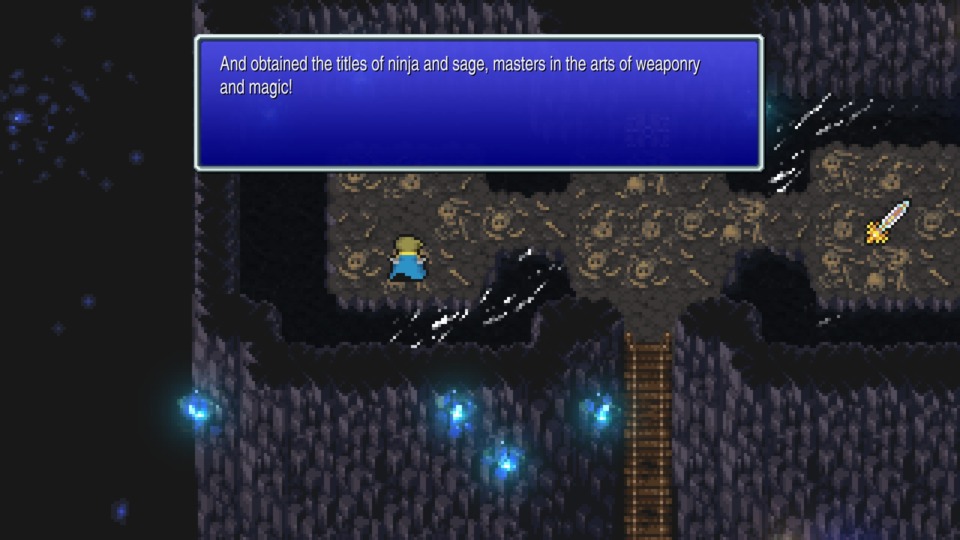
For those unaware, at the first level of the Crystal Tower, you can use a "Eureka Key" on a mirror to initiate a final optional dungeon, which leads to the two best classes in the game, Sage and Ninja, as well as merchants that sell the best items, weapons, and spells. And the game makes you work for these jobs, by the way. It's not as if you apply the key to the mirror, and the game gives you a cheat code. This dungeon has eight floors, each with zig-zagging patterns that make navigation a bother, and six boss battles, though only one is required. That said, the optional bosses are manifestations of elite weapons, so you are better off fighting them regardless. Exploring every corner of this dungeon is also advisable, as its loot is among the best in the game. There are even encounters in this dungeon that provide more significant and accessible EXP drops than what you'll fight in the Crystal Tower, and there's a save point leading up to the merchants. But the key to those merchants, which is not a secret, is to avoid the two you first encounter and find the secret merchant that sells Shurikens. Each one costs 65,500 Gil but has a base attack rating of 200, which far exceeds any of your other weapon options in the game. Shurikens are busted in all versions of Final Fantasy III, and it's great. Any RPG that expects you to play it for more than thirty hours should have at least one option for those who are done playing by the rules and just want to see the end, and that's precisely what Final Fantasy III does.
Part 10: The Worst-Designed Final Fantasy Final Boss Ever Made
So, you've got some cheesy bullshit to help you against one of the most notorious final bosses in Final Fantasy history! That must mean that everything is kosher, right? Well, not so fast! First, while the Sage can use White, Black, AND Summoning magic, they have fewer spell slots than the previous tier of magic casters that specialized in those schools of magic. Second, the equipment and armor sets for the Ninja are costly, meaning you'll likely only have the means to sport one or two at their full potential, and a third will pull one-third of its weight. Third, there is the matter of you needing to complete ONE MORE dungeon sequence with a final boss rush to boot! And this final dungeon does ye olde JRPG trope where it takes the previous bosses from the story and has them spawn as random encounters! Why? Because this game hates you! Typically, in JRPGs, there comes a point when you "turn the corner" on the game's difficulty and lay waste to everything the game has to offer by simply spamming tactical nukes whenever you have the option to attack. You can still do that in Final Fantasy III, but the game makes you work the longest in series history to get to that point.
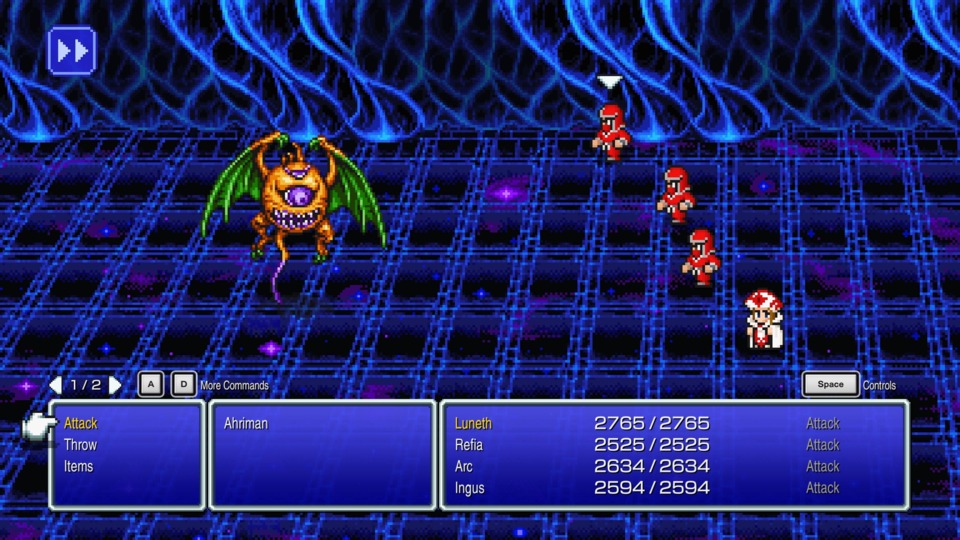
Also, to no one's surprise, Xande wasn't the evil force in complete control over the story's direction! Upon defeating him, you are greeted by the Cloud of Darkness and are thrust into a forced loss boss encounter against them before being tossed into the World of Darkness. If you enter the World of Darkness down on items and important expendables, you are shit out of luck because there's no turning around and taking a rejuvenating rest in your airship. There's also no save point in the World of Darkness until the very end, which means that the last dungeon and all of the bosses therein are meant to be played in a single session, which is utterly absurd. Oh, and the treasure chests in the World of Darkness, despite having incredible armor sets and valuable trinkets like Ribbons, are all Monster boxes that lead to encounters against clones of Xande! Like the boss they are based on, those clones spam all party-hitting spells like Meteor and Quake. There's so much in this dungeon where if you cannot figure out the OP strategy or are running away, you just get worked. The good news is that the dungeon itself is a linear affair with bosses leading up to the final encounter with the Cloud of Darkness, with incredibly easy-to-read hints on how best to beat them. On the other hand, the Could of Darkness is one of the worst-designed final Final Fantasy bosses ever made.
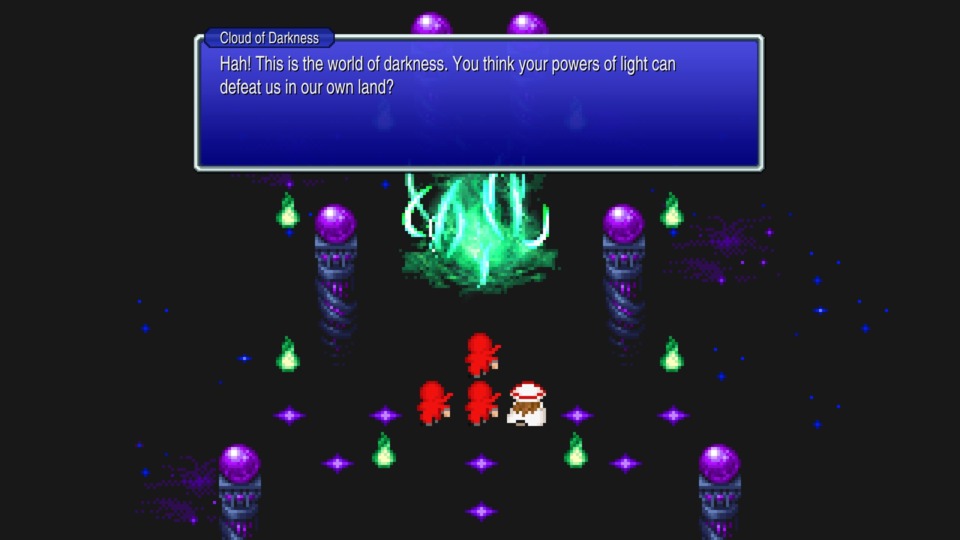
As I mentioned earlier, by the time you start making a dent in the foes in the World of Darkness, the move is to drop nuclear weapons on everything you are required to face, and that's a bit of a genre convention because it makes you feel good seeing all of your hard work leveling characters mean something. In the original game and Pixel Remaster, all the Could of Darkness does is power up their Flarewave ability and then deploy it. In the 3D remake, she's more of a bother because she gets two turns and can even buff herself with Haste and Protect and force you to deal with negative debuffs, thanks to her having Bad Breath. Nonetheless, she has one pattern, and the correct response to this pattern means this big epic boss battle boils down to a singular cycle of abilities and moves. When she uses Flarewave, your healer drops Curaja, and the characters not on healing duty do attacks. There's no nuance. If your best attackers are martial classes, you select the "Attack" command, and if they are magic-based, you fan through your magic menu. Your victory depends not on you employing a clever strategy or using the game's dynamic job system; it's an elongated battle of attrition. That is why many people, including myself, turn to using the Ninja's overpowered Shurikens when reaching the Cloud of Darkness. Every ninja star you land on the Cloud of Darkness saves you at least three turns' worth of your time. As a result, they are worth every bit of Gil they cost.
There's no honor in tackling this boss authentically, as there's no dynamism with how they behave or act. It's just the cheapest shit imaginable. Not everyone is of the same mindset as me about this point, but the final boss in an RPG shouldn't be the most demanding required encounter in the game. Some people tremble at the idea of the final boss in a JRPG being a cakewalk, but I'm of the opposite opinion. It's okay if you want the final boss to put up a little fight, but let me see the end. When I praised the ending and epilogue of Final Fantasy VI, did it bother me that you can beat Kefka by casting Ultima three times? Maybe a little bit, but that's the reward for putting over thirty hours of work into a game. Can you turn the Cloud of Darkness into a heap of shredded paper with high-tier characters with the best abilities? You sure can, but that involves you walking through a museum of rusty knives while blindfolded, as it requires you to burn elixirs and toil away on random encounters until you get nigh-level 99 characters.
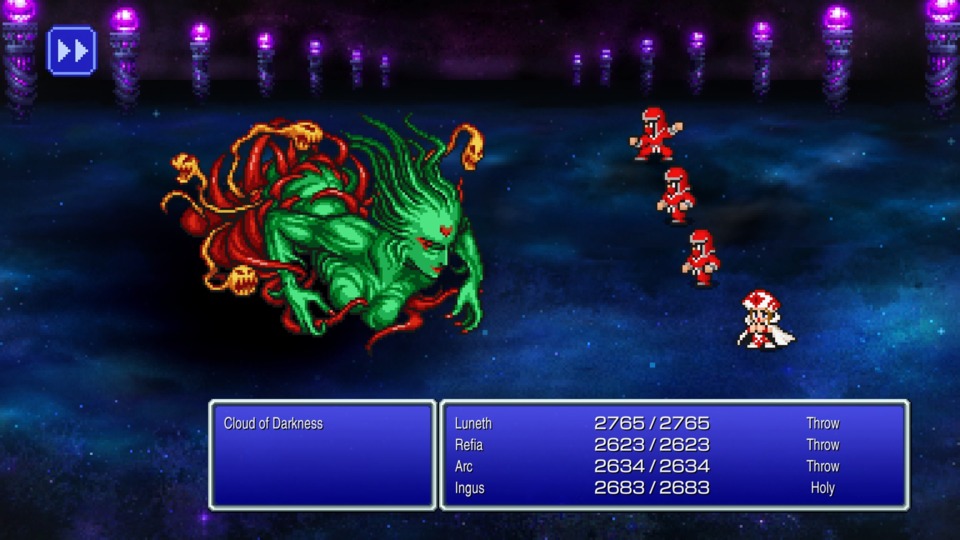
What is a shame is that the game's ending has its moments. The look of the World of Darkness is unique, and the stray bits of storytelling pull the narrative's threads together fairly compellingly. After the Cloud of Darkness murders your party, the game makes it clear that your characters are very dead. Still, the companions you encountered previously, including the ones who sacrificed their lives, return to remind you of their lessons about not fearing death. There are some fun callbacks before the game reveals that the World of Darkness isn't entirely a horrible place but an alternate world with its own set of heroes called the "Warriors of Darkness." To beat the Cloud of Darkness, your characters, the Warriors of Light, must free their dark counterparts from Cerberus, Echidna, Ahriman, and the Two-Headed Dragon. After summoning them, they bring your party back to life and encourage them to make the most of their second shot at the Cloud of Darkness, and this all involves cutscenes with relatively novel framing and direction for an 8-bit video game. And not to sound like a broken record, but Final Fantasy III's notions on life and death are a prototype of themes that become perfected in future entries in the series and the epilogue of the game wherein you see what everyone that helped you accomplish your mission does after the defeat of the Cloud of Darkness is also an example of that. The earnest epilogues of Final Fantasy IV, V, and VI owe a debt of gratitude to Final Fantasy III. As we near the end of this retrospective, I'll say the word "quaint" one last time before passing final judgment on the game.
Part 11: Is This Still Worth Going Back To?
Final Fantasy III is a crusty video game. The first game in the series still stands as the lone 8-bit entry in the series that I still feel comfortable giving to people and not feeling like shit after doing so. Nonetheless, there's a beauty to Final Fantasy III that is unmistakable. The bones of what defined nearly twenty years of the series' identity are here and sometimes for the first time. The novelty of seeing where those franchise traditions start is worth the price of entry alone. Likewise, watching the figureheads that dominated the highest of highs of the Final Fantasy series for three console generations trying to figure things out in a video game warmed my heart. Final Fantasy III's craft and care are there; you can feel the love its team of designers and programmers poured into it. The job system is far from perfect, but you have to tip your hat to the team for everything they did and for pushing the technical limits of the hardware they were working with.
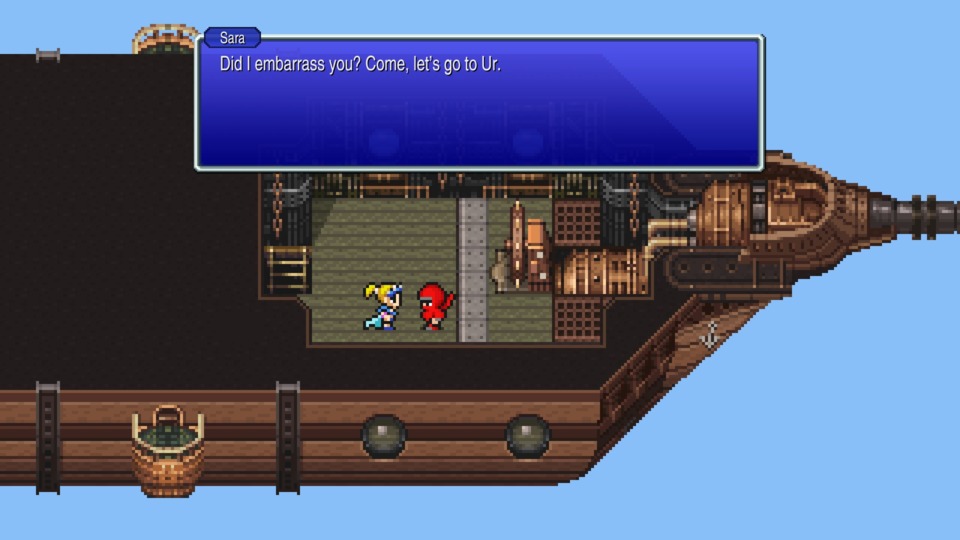
Unfortunately, Final Fantasy III is not an incredibly fun experience. There are times when it feels like a fun romp and other times when it feels downright malicious. The game's final act left such a sour taste in my mouth that I am still fuming about it to this day. When Final Fantasy III becomes a pain in the ass to play, it is a royal pain in the ass. The amount of grinding baked into its DNA is both tedious and disrespectful of your time. The job system, the game's main selling point, feels off. There's something profoundly dissatisfying about putting hours of time and attention into a job, only to have it become entirely worthless or succeeded by a different one you pick up at a later temple. The lack of passive buffs or a shared skill system means there are few opportunities for fun dual-classing or job synergies that future entries in the series would embrace. Likewise, everything progresses two or three clicks slower than it should, and you constantly feel like the game still has an advantage over you even when you do make progress. The lack of a satisfying moment where you can put all of the game's mechanical pieces together to stand victorious unless you put hundreds of hours into it is a bummer. There's no other way to say it.
Nonetheless, let's not be too hard on Final Fantasy III. The JRPG genre was still "finding itself," and the solutions to Final Fantasy III's problems were not entirely solved. Just last year, I decided to play Hoshi Wo Miru Hito (i.e., Stargazer), widely regarded as the worst JRPG ever made, and playing it was an "enlightening" experience. While it predated even the first Final Fantasy, it hits home how quickly one can foul up the "JRPG formula." Something as simple as having a sprite that displays towns in an overworld or ensuring that your walk speed feels right, don't sound like significant issues, but when they are even slightly off, they immediately sour the entire experience. Failing to display the final digit of your heroes' HP totals or forgetting to ensure your first purchasable weapon from shops does more damage than your fists? That might sound like a layup today, but they were real quandaries programming geniuses and experts only partially solved AFTER years of trial and error and experimentation. The fact that Final Fantasy III attempts as much as it does at the scale it operates is a miracle and showcases that the best and brightest minds in the video game industry have always graced this series.
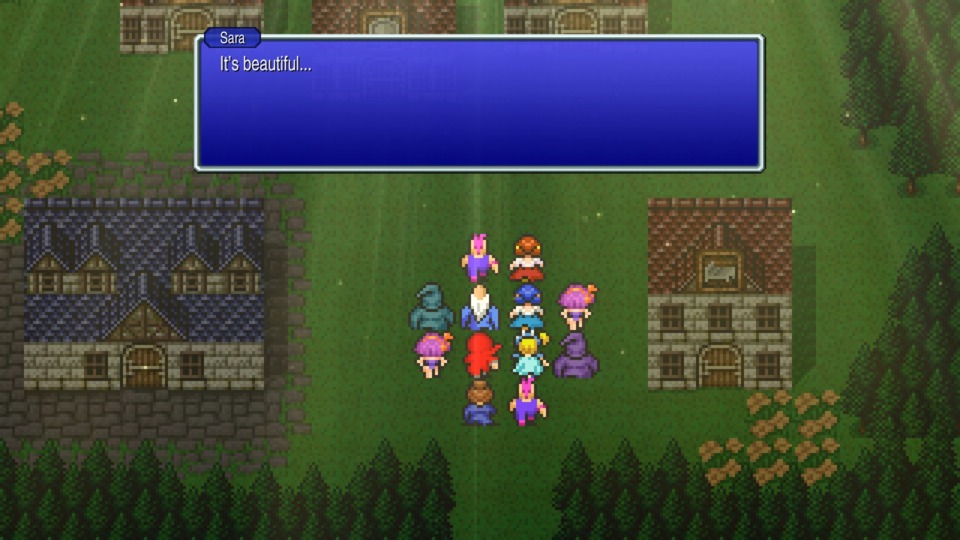
But suppose you are interested in playing a game from this era with a job system and all of the hallmarks of 8-bit game design. In that case, I have a better suggestion that might be slightly sacrilegious on a retrospective of Final Fantasy III. If Final Fantasy III seems even remotely in your wheelhouse or a game you think will tickle your fancy, you're 100% better off playing Dragon Quest III instead. Despite predating Final Fantasy III by nearly three years, its class system is far more user-friendly, straightforward, and rewarding than the one in Final Fantasy III. The team at Chunsoft was running circles around the Final Fantasy team at this time as Dragon Quest III not only has a multi-character party system that allows you to swap characters in and out however you please, but it also has a day-night cycle, item sorting tools, AND a non-linear open world. All in a game that was published in 1988! Dragon Quest IV even precedes Final Fantasy III, which I'm still shocked by. It has all of the novel features in Dragon Quest III plus a shockingly in-depth caravan system for those of you who like worrying about rations in tabletop RPGs, as well as a programmable artificial intelligence system that informed the design and implementation of the Gambit System in Final Fantasy XII. There's much more to the progeny of the Final Fantasy series than the people who made the games. Whether it be Yuji Horii, Richard Garriot, Robert Woodhead, Gary Gygax, or Dave Arneson, the influencers that guided its many creative pathways deserve huge props, especially from those of you excited at where the franchise is today. So, go back and play one of these crustier games. See how far things have come and better appreciate what we have today in gaming.
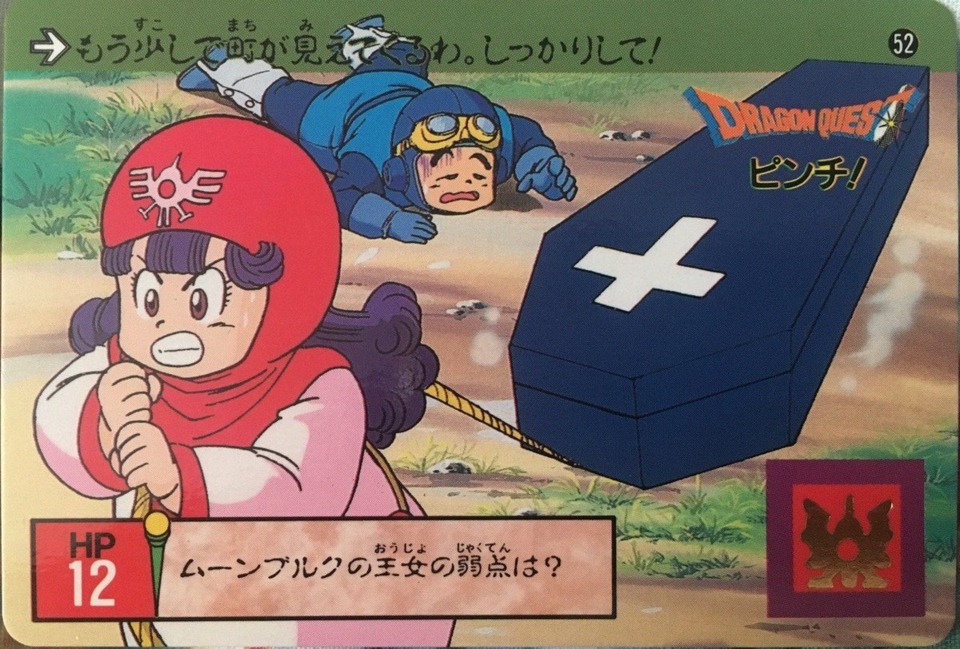
Log in to comment